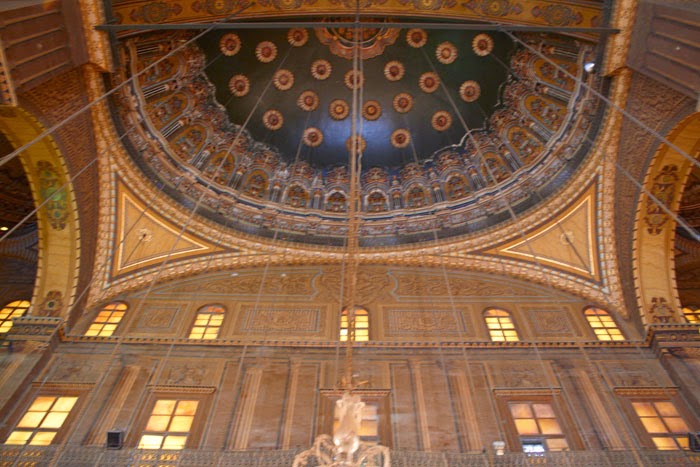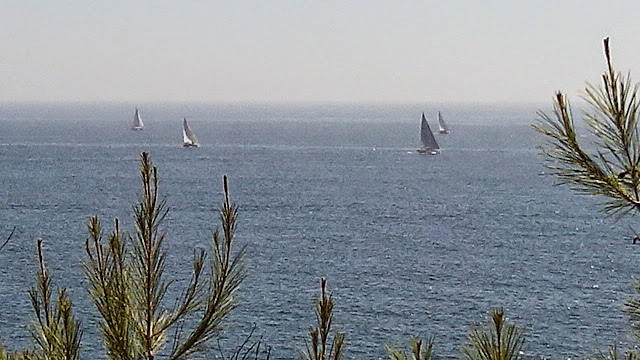O arquitecto foi o turco Yousf Boushnaq, de Istambul. Ele baseou os planos na mesquita Sultão Ahmed, em Istambul, começando a construção em 1830.
Mohamed Ali Mosque is amongst the most interesting mosques in Egypt. It stands on the highest point inside the citadel, and is also called the Alabaster Mosque.
The architect was Yousf Boushnaq, a Turkish man from Istambul. He based the plans on the Sultan Ahmed Mosque, in Istanbul, and the construction begun in 1830.
O principal material utilizado no revestimento foi pedra calcária, no entanto a parte inferior da mesquita e o adro foram cobertos com alabastro até uma altura de 11,5m.
The main matrial used for the construction was limestone, but the lower parts of the mosque, and the forecourt, are faced to a height of 11,5m with alabaster.
A mesquita tem formato rectangular e consiste em duas secções:
- a secção oeste, chamada de "Sahn" (esplanada)
- a secção este, chamada de "Beit Al Salah" (casa de oração)
The mosque is rectangular in shape and consists of two sections:
- the western section, called "Sahn" (courtyard)
- the eastern section, called "Beit Al Salah" (house of prayer)
"Beit Al Salah" (casa de oração / house of prayer)
A ESPLANADA / THE COURTYARD
Fonte no centro da esplanada para as abluções antes das orações.
Fountain placed in the center of the courtyard for the ablutions before the prayers.
Corpo do fontanário / Main body of the fountain
Pormenor do tecto por cima do fontanário.
Detail for the ceiling above the fountain.
Pormenor dos arabescos que circundam o fontanário.
Detail of the arabesques around the fountain.
A torre do relógio.
O relógio colocado nesta torre foi oferecido pelo Rei Luis XIV, de França em troca do obelisco que se encontra hoje na Place de la Concord, em Paris.
O relógio nunca funcionou.
The clock tower.
The clock placed in this tower was offered by king Louis XIV, of France in exchange for the obelisk placed in Place de la Concord, Paris.
The clock never worked.
A CASA DE ORAÇÃO / THE HOUSE OF PRAYER
 |
| Vista do interior da mesquita a partir da porta de entrada / View of the inside of the mosque from the entrance door |
Detalhe do tecto, à entrada
Detail of the ceilling, at the entrance
Mohammed Ali morreu antes de que a construção da mesquita fosse terminada, no entanto encontra-se sepultado aqui e o monumento fúnebre encontra-se na ala sul-este da Beit Al Salah (case de oração), do lado direito da entrada principal.
Mohamed Ali died before the mosque was complete but is buried here, in a tomb situated on the south-eastern side of Beit Al Salah, on the right side of the entrance.
A mesquita tem dois Minbars (pulpitos).
O original é o maior, feito de madeira com adornos dourados e trabalhados.
The mosque has two Minbars (pulpits).
The original one is the larger one, made of wood and with gilded ornaments.
O segundo Minbar é mais pequeno e feito de marmore. Foi um presente do rei Farouk em 1939.
Ao centro encontra-se o Mihrab (nicho). Este tem como função indicar a direcção de Meca e é onde se encontra o Imã enquanto conduz as orações.
The second Minbar is smaller and made of marble. It was a gift from king Farouk in 1939.
At the center there is the Mihrab. Its function is to point to Mecca's direction and is where the Imam is during the prayers.
O tecto da mesquita é impressionante com as várias cúpulas e meias-cúpulas decoradas com extrema riqueza.
Existem medalhões com os nomes de Deus (Allah), do profeta (Mohammed) e dos quatro Califas amençoados (Abou Bakr, Omar, Othman e Ali)
The ceilling of the mosque is impressive with its many domes and semi-domes, decorated with extream richness.
There are medallions around the dome, which include the names of Allah (God), Mohamed (the Prophet) and the four rightly guided Caliphs Abou Bakr, Omar, Othman and Ali.
A sensação dentro da mesquita é intensa. É de tal maneira rica em decoração que sentimos como que um assalto aos sentidos, parece que não vamos conseguir abarcar todos os detalhes.
The sensation inside the mosque is overwhelming. Its decoration is so rich that we feel like an assault to our senses, it seams like we will not be able to absorve all there is to see.
 |
| A ala da mesquita para as mulheres / The mosque's wing for the women. |
O lustre que está pendurado da cúpula maior, no centro da mesquita.
The chandelier that hangs from the main dome, at the center of the mosque.
















































